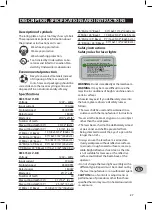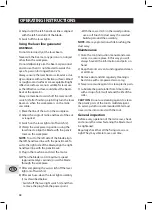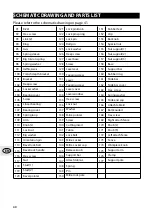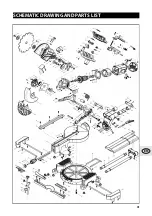
36
OPERATING INSTRUCTIONS
2) Loosen the mitre lock (25).
3) Rotate the mitre table (21) until the pointer
aligns with the desired angle.
4) Retighten the mitre lock (25).
WARNING
. Be sure to tighten the mitre lock
before making a cut. Failure to do so could result
in the table moving during the cut and cause
serious personal injury.
5) Place the workpiece flat on the table with
one edge securely against the fence (19). If
the board is warped, place the convex side
against the fence. If the concave side is placed
against the fence, the board could break and
jam the blade.
6) When cutting long pieces of timber, support
the opposite end of the timber with the side
support bars (37), a roller stand or a work
surface that is level with the saw table.
7) Use the clamp assembly (10) to secure the
workpiece wherever possible.
8) It is possible to remove the clamp assembly
(10) by loosening the clamp assembly lock
(11) and moving it to the other side of the tab-
le. Make sure the clamp assembly lock is tight
before using the clamp.
9) Before turning on the saw, perform a dry run
of the cutting operation to check that there
are no problems.
10) Hold the operating handle (7) firmly and
squeeze the switch trigger (24). Allow the
blade to reach maximum speed and slowly
lower the blade into and through the work-
piece.
11) Release the switch trigger (24) and allow the
saw blade to stop rotating before raising the
blade out of the workpiece.Wait until the
blade stops before removing the workpiece.
Cross-cutting (with slide action)
When cutting wide workpieces, first unscrew the
slide lock (29).
1) Pull on the release knob (6), raise the saw arm
(5) to its highest position and slide it towards
you.
2) Hold the handle firmly and squeeze the
switch trigger (24). Allow the blade to reach
maximum speed.
3) Slowly lower the blade into the workpiece
and slide it away from you at the same time
until the workpiece is cut.
4) Release the switch trigger (24) and allow the
saw blade to stop rotating before raising the
blade out of the workpiece.Wait until the
blade stops before removing the workpiece.
Bevel cut
A bevel cut is made by cutting across the grain
of the workpiece with the blade angled to the
fence and mitre table.The mitre table is set at
the zero degree position and the blade set at an
angle between 0º and 45º.
Use the slide action when cutting wide work-
pieces.
1) Pull on the release knob (6) and lift the saw
arm to its full height.
2) Loosen the mitre lock (25).
3) Rotate the mitre table (21) until the pointer
(22) aligns with zero on the mitre scale .
4) Retighten the mitre lock (25).
WARNING.
Be sure to tighten the mitre lock be-
fore making a cut. Failure to do so could result in
the table moving during the cut, causing serious
personal injury.
5) Loosen the bevel lock (16) and pull out the 0º
bevel adjuster. Move the saw arm (5) to the
left or right to the desired bevel angle (bet-
ween 0º and 45º).Tighten the bevel lock (16).
6) Place the workpiece flat on the table with
one edge securely against the fence (19). If
the board is warped, place the convex side
against the fence. If the concave side is placed
against the fence, the board could break and
jam the blade.
7) When cutting long pieces of timber, support
the opposite end of the timber with the side
bars (36), a roller stand or a work surface that
is level with the saw table.
8) Use the clamp assembly (10) to secure the
workpiece wherever possible.
9) It is possible to remove the clamp assembly
EN








































